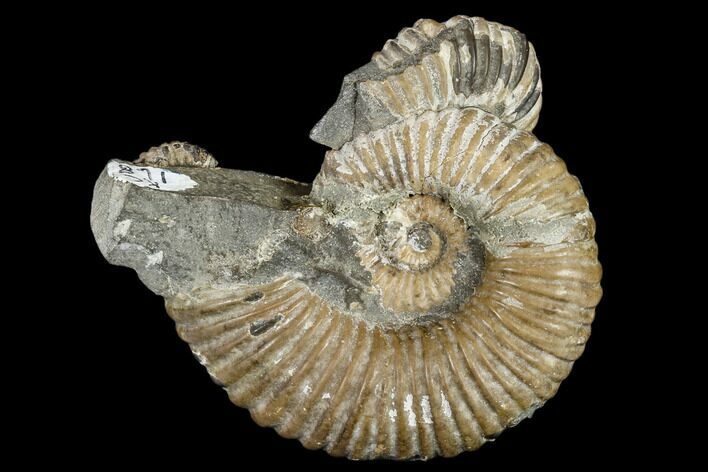This Specimen has been sold.
2.6" Wide, Cretaceous Ammonite Fossil Association - Australia
This is an ammonite of the species Australioceras jackii that preserved in association with a heteromorph ammonite that's likely of the genus Taxoceratoides sp.?. The rock surrounding this ammonite has almost completely been removed, though a section of the rock remains to hold the two ammonites together in their preserved state. These ammonites are Early Cretaceous, Albian Stage or approximately 110 million years old.
It comes with an acrylic display stand.
While most ammonites have spiral shells that retain the same shape throughout life, heteromorph ammonites have uncoiled shells. They likely had a different mode of life than other ammonites as the uncoiled shape would have slowed down swimming.
It comes with an acrylic display stand.
While most ammonites have spiral shells that retain the same shape throughout life, heteromorph ammonites have uncoiled shells. They likely had a different mode of life than other ammonites as the uncoiled shape would have slowed down swimming.
About Ammonites
Ammonites were ancient marine cephalopods, similar to today's squids and octopuses, but with a defining feature: their distinctive, tightly coiled spiral shells. These shells, resembling those of modern nautiluses, served as both a protective home and a buoyancy aid, allowing ammonites to navigate the prehistoric seas with ease. First emerging around 240 million years ago in the Triassic Period, ammonites thrived for over 175 million years, adapting through numerous forms and sizes. As predatory creatures, they likely fed on smaller marine organisms, using their tentacles to capture prey. However, their long reign came to an end 65 million years ago at the close of the Cretaceous, coinciding with the mass extinction event that also eliminated the dinosaurs.
Ammonites were ancient marine cephalopods, similar to today's squids and octopuses, but with a defining feature: their distinctive, tightly coiled spiral shells. These shells, resembling those of modern nautiluses, served as both a protective home and a buoyancy aid, allowing ammonites to navigate the prehistoric seas with ease. First emerging around 240 million years ago in the Triassic Period, ammonites thrived for over 175 million years, adapting through numerous forms and sizes. As predatory creatures, they likely fed on smaller marine organisms, using their tentacles to capture prey. However, their long reign came to an end 65 million years ago at the close of the Cretaceous, coinciding with the mass extinction event that also eliminated the dinosaurs.
SPECIES
Australioceras jackii & Taxoceratoides sp.?
LOCATION
Walsh River, Queensland, Australia
SIZE
Ammonite cluster 2.6" wide
CATEGORY
ITEM
#113158
We guarantee the authenticity of all of our specimens.
 Reviews
Reviews















